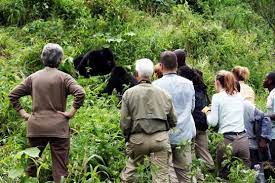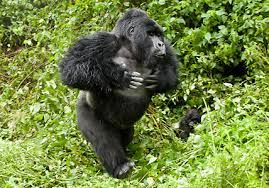What to do when a gorilla charges is one of the common questions asked by travelers visiting to see these endangered primates. Your safety in the jungle with gorillas is a key aspect on this lifetime experience. Whereas mountain gorillas are habituated/trained to get use with people, the endangered primates remain with some wild characters incase they feel insecure. This reminds all travelers trekking gorillas to be extra careful and follow the guidelines as given by park rangers. When a gorilla charges at you don’t run away suddenly or scream. You will likely be with other people on the trek including rangers and other travelers. Ensure to keep in a tight group and try to give way for the gorilla in a calm and non-threatening manner. In other words, pretend as if you’re doing something else such as touching vegetation without looking directly into its face.

In that manner, the primates will perceive that you are not a threat. Gorillas can charge at humans during gorilla trekking for several reasons including failure to adhere to gorilla rules. There’s no serious case recorded where tourists have been hurt by gorillas. Though, some visitors have been touched, grabbed and often times pulled and dragged down by the gorillas. With Gorilla Trek Africa, we guarantee you safety on your trip to see mountain gorillas
Why do gorillas charge?
Habituated gorillas are accustomed to human presence while the unhabituated ones are shy and will try to avoid humans when encountered. Despite being habituated, gorillas remain wild animals. They can charge and become aggressive when they feel threatened in their natural habitat. There are several things that cause the primates to charge. In particular, gorilla charge may occur during trekking in which visitors spend 1 hour watching the primates in the wild. Before visiting gorillas there are rules and guidelines for visitors to follow including maintaining a distance of 7 meters, keeping silence among others. These rules are meant to protect the primates from disturbances while offering humans a peaceful and safe way to see them. Observing these rules may not be 100% fulfilled given that some playful young gorillas tend to move closer or even touch visitors. The reaction from such an interaction is always unpredictable. If that happens, there’s no straight answer on what to do. Though, you can respond with a gentle touch and stand still. Your ranger is always watchful to help you out.
Most important thing to note is that failure to observe some of the gorilla rules is the most common cause for gorillas to charge at visitors. For instance making sudden movements, loud noise, pointing at and surrounding off the gorillas among others actions that attempts to disrupt their normal feeding habits. Such things can irritate the gorillas. The silverback who is responsible for protecting his family will perceive such acts as a threat to his group. Usually, it responds with powerful chest thumbs while making loud groans, tearing and throwing vegetation. These should be warning signs that the gorilla is charging at you. In that case scenario, the best thing to do is to avoid the charge so that it doesn’t become aggressive.

Tips to avoid a gorilla charge
• Ensure to keep together in a tight group with fellow visitors and rangers when watching the gorillas.
• Always ask your ranger for guidance before doing something. For example, when taking photographs, it can be tempting to move away from the group or get to close for a better shoot.
• In case a gorilla comes towards you, don’t run away suddenly. Instead try to calm down, take a step back to give way for the gorilla to pass. By being submissive makes a gorilla think you’re not a threat.
• If a gorilla has charged showing signs to attack you, stay stand still and don’t shout or runaway.
Are gorillas dangerous animals?
 The study of mountain gorilla ecology and behavior indicates that mountain gorillas are powerful yet peaceful animals. First conducted by George B Schaller in 1964, the gorilla is the largest primate in the world and shares 98% of DNA with humans. The weight of a mature male silverback gorilla is 300 to 400 pounds and its height can reach 4 to 6meters tall. Given the power a gorilla possess, the early hunters and explorers judged it as fierce and aggressive. This image has changed following further scientific research conducted by Dian Fossey who established Karisoke Research Center in 1967. Today there’s international consensus that gorillas both wild and habituated are peaceful animals. While studying mountain gorillas in Volcanoes National Park Rwanda, Fossey ensured to get closer to the primates by imitating their vocals and behavior including walking on knuckles and chewing on vegetation. Eventually she gained the gorillas’ trust and accustom the primates to her presence. This practice known as gorilla habituation experience is now available in Bwindi Impenetrable Forest National Park. The gorilla habituation offers 4 visitors a chance to spend 4 hours with semi-habituated gorilla group in Rushaga sector southern part of Bwindi.
The study of mountain gorilla ecology and behavior indicates that mountain gorillas are powerful yet peaceful animals. First conducted by George B Schaller in 1964, the gorilla is the largest primate in the world and shares 98% of DNA with humans. The weight of a mature male silverback gorilla is 300 to 400 pounds and its height can reach 4 to 6meters tall. Given the power a gorilla possess, the early hunters and explorers judged it as fierce and aggressive. This image has changed following further scientific research conducted by Dian Fossey who established Karisoke Research Center in 1967. Today there’s international consensus that gorillas both wild and habituated are peaceful animals. While studying mountain gorillas in Volcanoes National Park Rwanda, Fossey ensured to get closer to the primates by imitating their vocals and behavior including walking on knuckles and chewing on vegetation. Eventually she gained the gorillas’ trust and accustom the primates to her presence. This practice known as gorilla habituation experience is now available in Bwindi Impenetrable Forest National Park. The gorilla habituation offers 4 visitors a chance to spend 4 hours with semi-habituated gorilla group in Rushaga sector southern part of Bwindi.
In conclusion, mountain gorillas are wild animals! Be cautious and careful when a gorilla charges to avoid being hurt. For more travel tips and bookings, Contact Gorilla Trek Africa.




